LS1: The Engine That Changed it All The LS1 (5.7 liter, 346ci) was the engine…
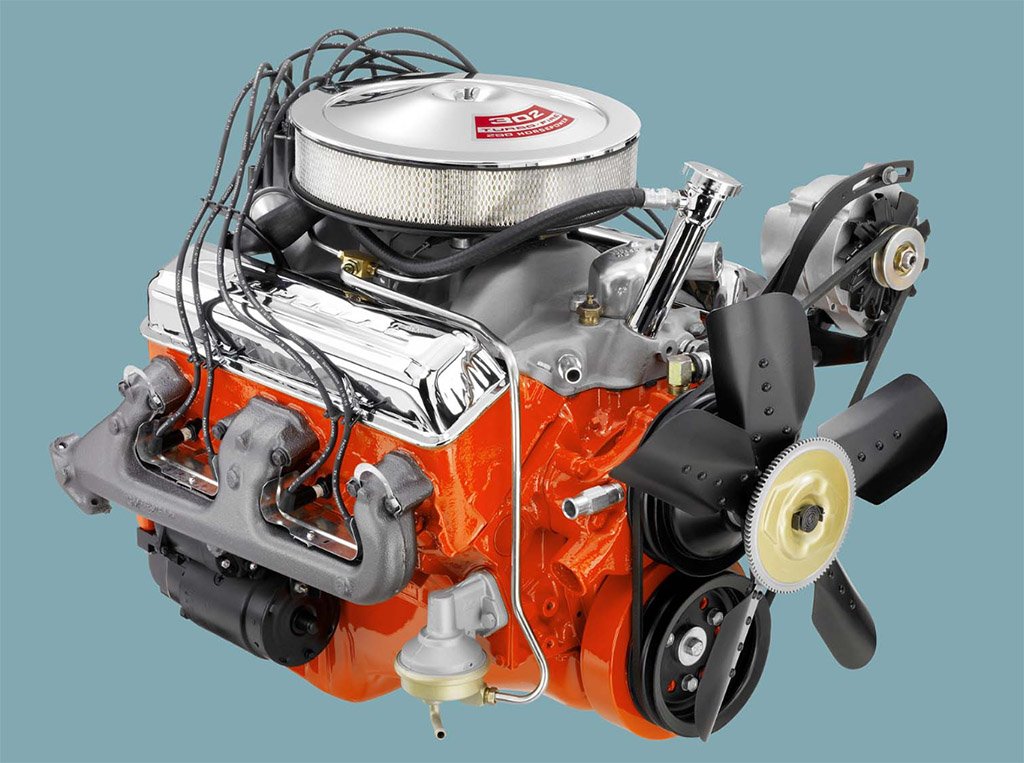
A Retrospective on the Legendary Small-Block Chevy V8: Its Journey Through the Years – Part 1
To celebrate HOT ROD’s 75th anniversary, we teamed up with CASTROL GTX to bring you some of the stories that exemplify the core of what HOT ROD is and reflect the brand’s influence on America’s car culture. Clickhereto learn more about CASTROL GTX.
It’s not unreasonable to say the Chevrolet small-block V-8 changed the face of automotive engine history. Innovative and technologically advanced when it debuted in 1955, it greatly influenced future V-8 engine designs, both inside General Motors and among the competition. Enthusiasts embraced it and an entire performance aftermarket sprang up around it. Over the decades, variations of the small-block Chevy V-8 have been used in race cars, off-road trucks, boats, and even custom motorcycles. It can also be found under the hood of everything from classic Ford hot rods to radical Jeep conversions.
“The small-block Chevy is unquestionably the dominant domestic engine both in terms of sheer numbers and also in terms of longevity,” said Jeff Smith , former senior technical editor for Car Craft magazine. He cites the engine’s interchangeability as one of the biggest reasons for its popularity. “It’s possible to swap a set of heads from a 1990 Vortec truck engine onto the original ’55 265. I doubt another engine was ever built (perhaps the VW flat-four) that allowed you to swap parts from 45 years apart.”
“The aftermarket loves engines like the SBC because they knew that if they invested in a decent design, like a good-flowing cylinder head or a well-designed performance camshaft, that the design would have a decade or more worth of longevity,” Smith added.
Bill Tichenor, director of marketing for Holley Performance Products, echoed Smith’s sentiments. “It is not unreasonable to say Holley has sold more speed parts for small-block Chevys than all other engines combined. There are great engines from Ford, Chrysler, and others , but the proliferation of cores and affordability of making power with a small-block Chevy made it rise to the top. They certainly have been the engine of choice for street-rodding, Chevy muscle cars and trucks, circle track racing, and a lot of drag cars, as well,” Tichenor said.
The 1917 288-Cubic-Inch Series D Was Actually Chevy’s First V-8
Interestingly, the small-block Chevy was not the first V-8 in the brand’s history. From 1917 to 1919, some 3,000 cars were equipped with the little-known Chevy Series D V-8. The 288-cubic-inch (4.7-liter) V-8 had a 4.75:1 compression ratio and produced 55 horsepower at 2,700 rpm. The Series D was the first overhead-valve V-8 and featured an exposed valvetrain, nickel-plated valve covers, and a water-cooled aluminum intake manifold.
Three-and-a-half decades after that initial effort, the small-block Chevy was born. Developed as a replacement for Chevrolet’s “stovebolt” six-cylinder engine, the 265-cubic-inch (4.3-liter) “Turbo-Fire” engine arrived in 1955 as an option for the Bel Air and Corvette. Its compact, lightweight design featured 4.4-inch bore spacing and a thin-wall casting to reduce weight. An internal oiling system, and the potential to bore and stroke it far beyond the factory limit of 400 cubic-inches (Gen I engines), contributed to its long-term success.
We’ve put together the following list of the most impressive small-block Chevy V-8s in the brand’s history. Enjoy the V-8 power trip down memory lane.

265 Turbo-Fire V-8
The 265 arrived on the scene with a 3.75-inch bore and 3.00-inch stroke (95.2 and 76.2 mm, respectively). It made 162 horsepower and 257 lb-ft in base form with a two-barrel carburetor. An optional Power Pack added a four-barrel carburetor (and other modifications) taking power up to 180 horsepower and an even 260 lb-ft of torque. When fitted to the Corvette, the 265 made 195 horsepower through a dual exhaust system. Later in the year Chevrolet added a Super-Power-Pack option to the Bel Air, taking it to Corvette power levels.
In 1956, the 265 in the Corvette was available in three more powerful flavors: 210 horsepower with a single four-barrel carburetor, 225 horsepower with “dual quads,” and 240 horsepower with the dual four-barrel carburetors and a high-lift camshaft. Its compact size was made possible by consolidating accessories. According to GM, it used a one-piece intake manifold that combined the water outlet, exhaust heat riser, distributor mounting, oil filler, and valley cover into a single casting.
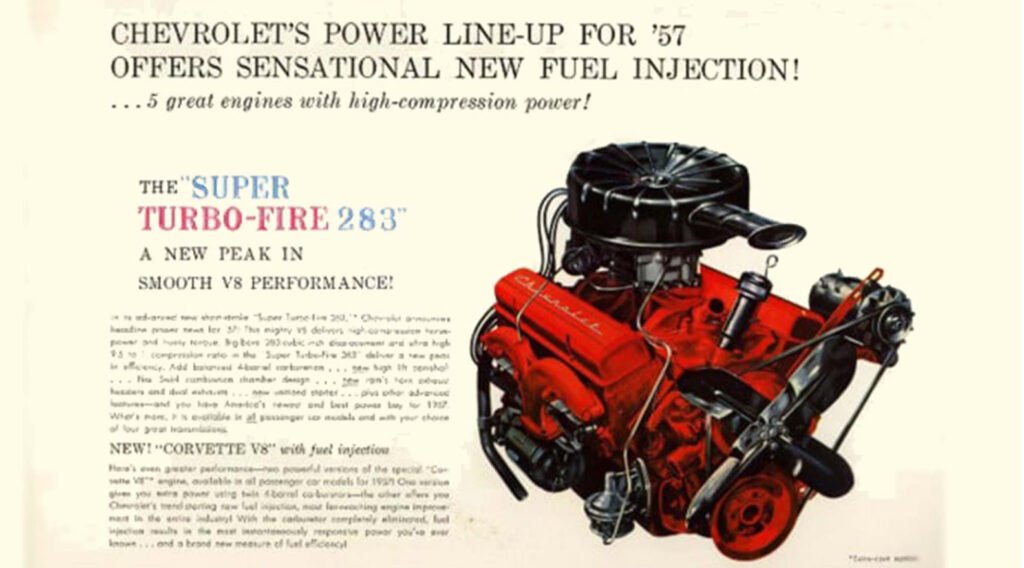
283 Super Turbo-Fire V-8
The small-block Chevy was blessed with more displacement in its third year (the 162 horsepower 265 was still the base engine). A larger 3.875-inch bore brought the “Mighty Mouse” up to 283 cubic-inches (4.6 liters). Early 283s used 265 block castings, but thin cylinder walls contributed to overheating. The issue was caught early on and subsequent 283 engine blocks were specifically cast to prevent the problem.
The 283, dubbed Super Turbo-Fire, came with a choice of a carburetion or mechanical fuel injection. It made 185 horsepower with an 8.5:1 compression ratio and two-barrel carburetor, 220 horsepower with 9.5:1 compression and four-barrel carburetor, and either 245 or 270 horsepower when fitted with dual four-barrel carburetors and the higher compression ratio.
Models equipped with the Rochester Ram-Jet fuel injection system made 250 horsepower, but the most powerful engine of the lot was the 283-hp fuel-injected Super Ram-Jet with its 10.5:1 compression ratio, helping it achieve the coveted one-horsepower-per-cubic-inch status. In MotorTrend testing at the time, a 1957 Corvette fitted with the Super Ram-Jet reached a top speed of 132 mph at the General Motors Proving Grounds outside of Milford, Michigan.

327 Chevrolet V-8: A Bigger, Badder Small-Block
By 1962, a 170-horsepower version of the 283 became Chevy’s base V-8, but optional small-block V-8s received a full 4.00-inch bore and a longer stroke, at 3.25 inches, for a total displacement of 327 cubic-inches. The optional 327 was available with 250, 300, or 340 horsepower, depending on the four-barrel carburetor and compression ratio. The Corvette was still available with mechanical fuel injection, which pumped out 360 horsepower with an 11.25:1 compression ratio.
The 327-cubic-inch small-block reached its peak power rating in 1965: 365 horsepower with a four-barrel Holley carburetor or 375 (1.15 hp/cu-in) with the Rochester Ram-Jet fuel injection system. By mid-1965, the 327 played second-fiddle to the 396-cubic-inch big-block that debuted in the Corvette. It soldiered on as the base engine, with a choice of 300 or 350 horsepower. It remained as a step up from the base 283s (and later 307s) in passenger cars and the base engine in the Corvette until the 350 (first seen in the 1967 Camaro) was introduced into America’s sports car in 1969.
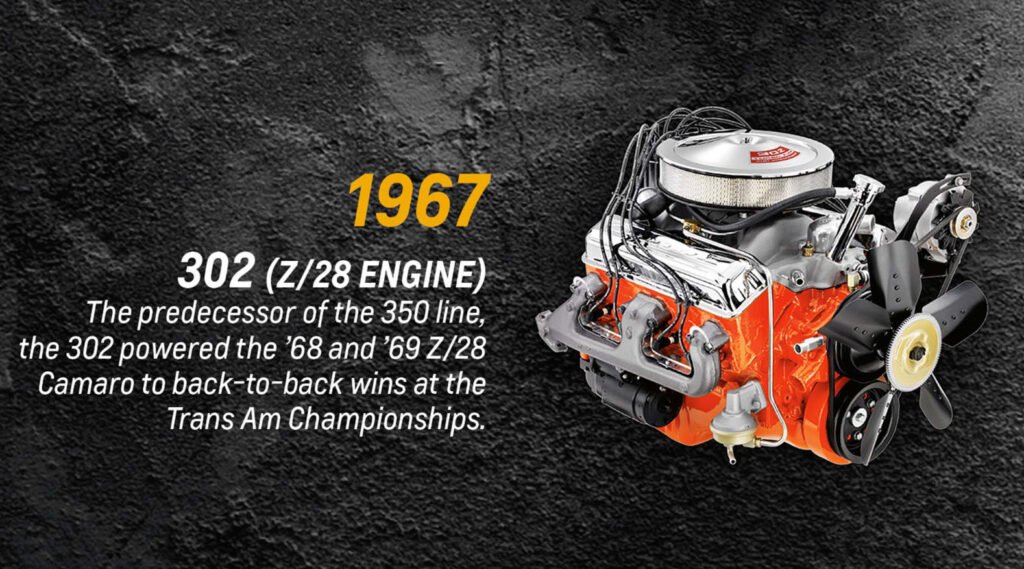
302: A Legendary Small-Block for the Legendary Z/28 Camaro
The Camaro was Chevy’s response to the Ford Mustang . Besides defending GM’s entry-level brand, the Camaro introduced two small-block displacement landmarks. First was the 302-cubic-inch engine designed for SCCA Trans Am competition. The 302 was created by combining the 327’s engine block casting (4.00-inch bore) with the 283’s crankshaft (3.00-inch stroke). This engine was built for competition and featured plenty of race car kit, including an 11:1 compression ratio, four-bolt main caps, a solid-lifter camshaft and solid valve lifters, high-rise intake manifold topped with an 800-cfm Holley four-barrel carburetor, high-capacity oil pump, and baffled oil pan. It exhaled through a 2.25-inch dual exhaust system. The engine was finished with a chrome-plated air cleaner, rocker covers, filler tube, and cap.
Camaro owners who opted for the Z/28 package were rewarded with a 302 pumping out 290 horsepower at 5,800 rpm and 290 lb-ft of torque at 4,200 rpm. Many believe the horsepower rating was conservative. Z/28 owners found a box with tubular headers in the trunk. With the headers installed, a proper carburetor main jet, and ignition tuning, it produced around 376 horsepower. Race engines with dual quads made as much as 465 horsepower. During its three-year production run, more than 19,000 Camaro buyers opted for the Z/28, and with good reason.

The Legendary 350 V-8
The 1967 Camaro also brought the world the first 350-cubic-inch small-block Chevy V-8 . This engine would eventually be used in passenger cars and trucks in nearly every imaginable state of tune. Like the 302, it was based on the 327 block, but the 350 had an all-new crankshaft with a 3.48-inch stroke. The first version, dubbed the L-48, produced 295 horsepower and 380 lb-ft of torque. The 350 became available in the Nova in 1968, and in its third year was optional across the Chevrolet passenger car line. It replaced the 327 as the base engine in the Corvette in 1969. Power fluctuated during the 1970s fuel crisis, and many versions of the 350 emerged. At its lowest point, the 350 was rated at a mere 145 horsepower (net).

More Power for the 350, Including the Hot LT-1
It didn’t take long for the small-block Chevy to regain its reputation as a powerhouse. The L-48 and ZQ3 both hit the 300-horsepower mark. Two other versions surpassed those numbers: the 350-horsepower (net) L-46, optional in the 1969 Corvette, and the LT-1 in 1970. The LT-1 came ready to battle, with solid lifters, 11:1 compression, high-po camshaft, and a 780-cfm Holley four-barrel carburetor that sent fuel and air through an aluminum intake manifold. Exhaust gasses exited the combustion chamber through ramhorn manifolds and a high-flow exhaust. In 1970, the LT-1 cranked out 370 horsepower (gross) and was available in the Corvette ZR-1 and Camaro Z28. Just two years later, the power level dropped to 255 horsepower (net) due to new Federal regulations.
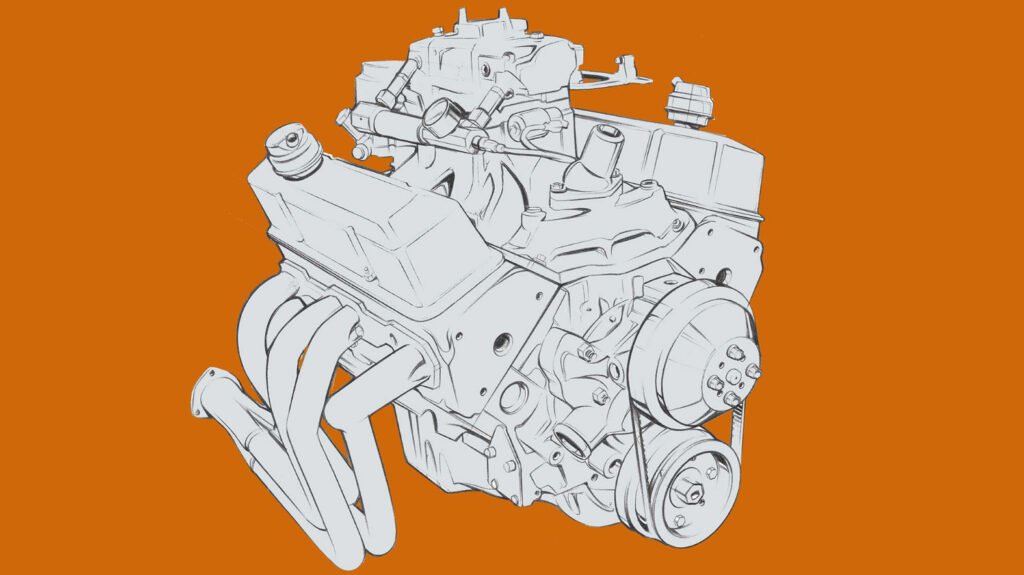
The Biggest Small-Block So Far: The 400-Cubic-Inch V-8
The largest version of the Generation I small-block was the 400 (6.6 liter) . It was the only engine available with both the 4.125-inch bore and the 3.75-inch-stroke crankshaft. It debuted in 1970 and was produced for 10 years. It featured Siamesed cylinders for greater strength, with the larger bore and a larger 2.65-inch rod journal. Early models produced 265 horsepower with a two-barrel carburetor. A four-barrel carburetor option became available in 1974. In its darkest hour it only made 145 horsepower. Regardless of horsepower rating, the 400 was a torque monster. The engine was available in full-size A-body and midsize B-body Chevy passenger cars until the end of the 1976 model year, and it soldiered on a few more years in full-size pickups.
It didn’t take long for hot-rodders to put the 400’s 3.75-inch-stroke crankshaft in a 350 engine block, creating the 383 stroker. Water jackets in between all cylinders in the 350 block resisted overheating, unlike the 400 block, which didn’t have that cooling advantage. Although the 383 was never offered as a factory option, this configuration’s popularity prompted GM to offer a 383 crate motor in its performance catalog.

The 350 V-8 Gets Tuned-Port Injection!
It took nearly 15 years before the Chevy 350 got an injection of power. The L98 began the slow process of evolving the engine line to a modern EFI system. GM blessed the L98 350 with an all-new tuned-port fuel injection system, to be forever known by Chevy fans as the TPI, and recognized by its elephant-leg runners. Although it was only rated at 230 horsepower, it was a step up from the 205-horsepower L83 from the year prior. By 1991, power reached 245 horsepower in the Camaro and Pontiac Firebird , and 250 horsepower and 345 lb-ft of torque in the Corvette.
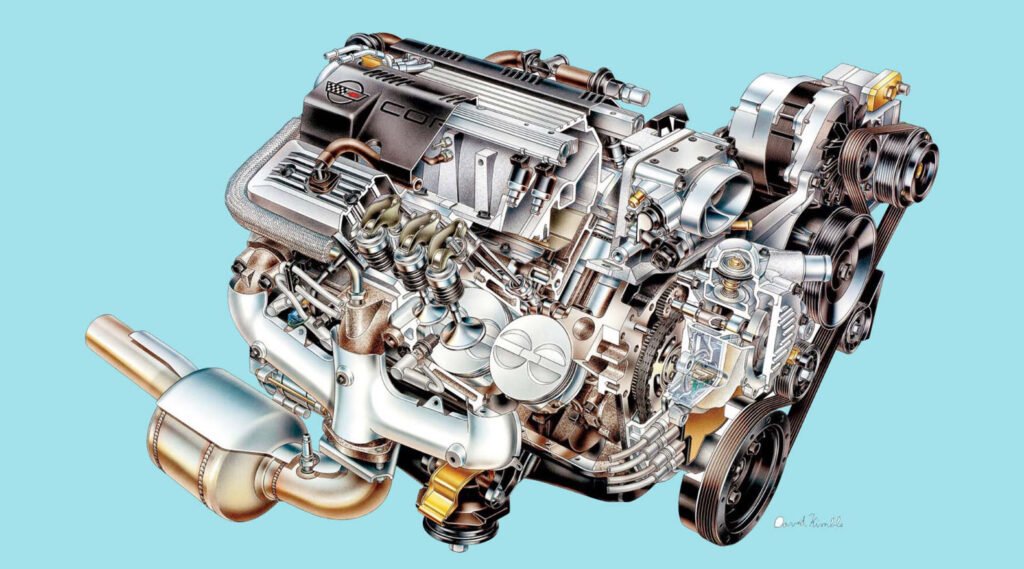
The Gen-II Chevy Small-Block V-8, the LT1
The Corvette has always been a testbed for Chevrolet’s latest technologies, and the 1992 model with the Generation II LT small-block was no different. Though many parts were interchangeable between Gen I and Gen II engines, the LT used a new block and head design with “reverse flow” cooling system that sent coolant through the cylinder heads first before flowing down through the engine block. The heads and combustion chamber stayed consistently cooler, allowing higher compression and more spark-advance for increased power. The water pump, intake manifold, and damper/pulley system were all unique to the Gen II small-block. However, GM wisely kept the engine mounts and bellhousing bolt-pattern the same so hot-rodders could transplant the new engine into older chassis.
The 1992 Corvette made 300 horsepower and 330 lb-ft of torque. The fourth-generation F-Body twins (Chevrolet Camaro and Pontiac Firebird) gained the LT1 for their 1993 4th-gen redesign and were rated at 275 horsepower and 325 lb-ft of torque. The engine was also available in the full-size B- and D-body GM vehicles. Most memorable is the 1994 to 1996 Chevrolet Impala SS, with 260 horsepower and 330 lb-ft of torque. All engine blocks were iron, but Corvettes and F-body cars had aluminum heads. Full-size cars had iron heads. For 1996, Corvettes equipped with six-speed manual transmissions (including all Grand Sports) were powered by a limited-run (6359 units), 330-horsepower LT4 engine with 340 lb-ft of torque. In 1997, the Chevrolet Camaro SLP/LT4 SS and Pontiac Firebird SLP/LT4 Firehawk were available with the LT4. Only 135 F-bodies were built with the LT4.
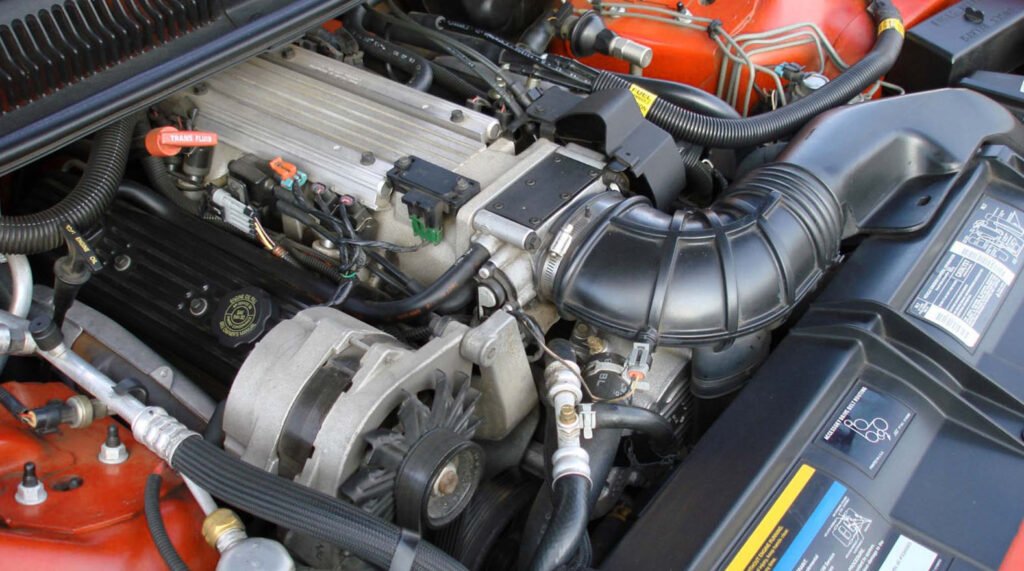
The Gen-II LT1’s New Technologies Weren’t Without Faults
The Gen-II LT1 used a speed-density fuel-management system with batch-fire fuel injection in its first two years. In 1994 it received a mass airflow sensor and sequential port injection. The engine control module (ECM) was also replaced with a more powerful control module (PCM). The 1994 Corvette received the new OBD II system for testing before the government mandated requirement began in 1996.
The new engine wasn’t without its faults. Early models were plagued by a small design flaw in the Opti-Spark distributor. Vacuum vents were added to the distributor to remove the moisture that affected its spark ability. Unfortunately, the water pumps leaked water and coolant into the vents, ruining the distributor. Although not as popular as the original small-block Chevy (or the later LS engine family) the LT1/LT4 still appeals to many enthusiasts. If you have a Gen-II LT1 then hit up the aftermarket for Opti-spark solutions .
“Perhaps the only hiccup in the SBC lineage was the LT1/LT4 variation, with its reverse cooling and Opti-Spark ignition variables that made that engine less popular. And yet, it still commands interest despite its very short lineage,” said Smith.




Comments (0)